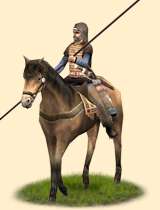Uaezdaettae Mizdagânîh (Nomadic Noble Mercenary)
 |
Weapons | Defence | Mental | ||||||
|---|---|---|---|---|---|---|---|---|---|
| Primary | Secondary | Armour: | 5 | Morale: | 15 | ||||
| Type: | none | spear | Shield: | 0 | Discipline: | disciplined | |||
| Attack: | 6 | 4 | Skill: | 11 | Training: | highly_trained | |||
| Charge: | 34 | 34 | Recruitment | Other | |||||
| Lethality: | 1 | 0.4 | Soldiers: | 25 | Hit Points: | 1 | |||
| Range: | 190.4 | 0 | Cost: | 2174 | Mass: | 1 | |||
| Ammo: | 40 | 0 | Upkeep: | 544 | |||||
| Turns: | 1 | ||||||||

A nomadic mercenary general, with his handpicked bodyguard of highly skilled cavalry.
Superior
Disciplined
Very Hardy
Can Form Cantabrian Circle
Not all of generals of nomadic armies were related by blood or marriage to the ruler of the clan. Not only could men be given command of the army by demonstration of outstanding skill, but mercenary generals could be hired as well. Fighting for the highest bidder (including their richer civilized neighbors), these men would have spent years fighting, occasionally on multiple sides in a single war. Either lesser nobles or even members of the tribe not born into the nobility, these men are often highly skilled in the art of war, as well as being adept to the requirements of the harsh nomadic culture. Their bodyguards, mounted on fine mounts, armed with composite bows and a kontos and armored with a scale cuirass (Though perhaps not as fine as the equipment of the royalty) would have been battle-hardened and ready to fight, as long as the gold continues to flow.
Nomadic mercenaries were found in many of their neighbors' armies, and certainly were available for higher nomadic royalty as well. Scythians and Saka were found as mercenaries in Persian armies, primarily as cavalry (Although in rare cases also as infantry during the Achaemenid worldly order). They knew their worth well, especially their qualities as horsemen. One such notorious case was during the campaign of Seleucid King Antiochus VII Sidetes against the Parthian sovereign Phraates II, where the Seleukeis had hired them as mercenaries to pincer the Parthians from the other flank; They had arrived too late, and could not receive their pay as the Seleucids were defeated. They ravaged their employer’s or rather the hard-earned Parthian empire after not receiving pay and were finally content when they had murdered Phraates after being handed over by discontent Hellenic mercenaries. Saka horsemen were also found in Parthian armies often as the result of a treaty, and were most probably present in the famed battle of Carrhaë 53 BCE when the chief of the eastern Parthian house of the Sûrên-Pahlav, Surena had decisively defeated an invading Roman army lead by triumvir Marcus Licinius Crassus.
Sauromatae mercenaries were found in both Parthian and Roman armies, the most famous being the Iazgyes who started being recruited in Roman armies in 69 CE. Their warlike reputation was no less than that of the eastern Saka and were constantly a threat to the populations within their sphere of influence; Parthians, Caucasian Albanians and Iberians, Armenians, the Graeco-Scythians of the Crimean Bosphorus and the Getic tribes all eventually recognized the merit of their cavalry.